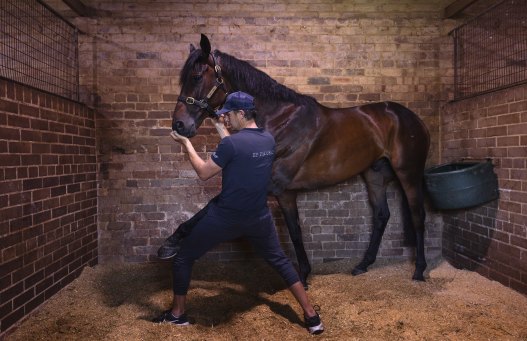This was published 5 months ago
Meet Tom Simpson, the horse physio to the stars
By Andrew Wu
Tom Simpson has worked with some of Australia’s best racehorses. He can tell if they are happy by the look in their eye, the pricking of their ears and the movement of their mouth. But don’t dare call him a horse whisperer. He’s a horse physio.
In horseracing, this is a profession that is not as common as one would think. Horses are no different to human athletes. They get sore after competition. No elite sports team in the country would operate without a qualified physiotherapist. Why would racing be different?

Horse physio Tom Simpson with Melbourne Cup contender Athabascan at Randwick racecourse.Credit: Dominic Lorrimer
When Simpson, 45, started 20 years ago the treatment of horses was not as specialised. Horse physiotherapy was not a thing. Simpson figures there would now be about “half a dozen” active equine physios in the country with qualifications in both human and horse physiotherapy
Simpson, who has a small team that services stables in Melbourne, Sydney and Brisbane, is a horse physio to the stars.

Horse physio Tom Simpson works on stayer Athabascan.Credit: Dominic Lorrimer
Last week, he ran the rule over Via Sistina after her misadventures at Moonee Valley. In the coming days, he will help apply the finishing touches over several Melbourne Cup runners, including the favourite Buckaroo.
Champion trainer Chris Waller and global giant Godolphin both use the Sydney-based Simpson, so do Gai Waterhouse and Adrian Bott, the Hawkes family, Peter Snowden, John O’Shea and Annabel Neasham.
“Their ears are a really big thing, whether they’re forward or backwards. Ears backwards are ‘leave me alone’, ears forwards are great.”
Physio Tom Simpson
“It was the old horseman, in inverted commas, that would go and do whatever they did – and it was a big mystery,” Simpson said of attitudes to the role in the past.
“It’s become a bit more science – and evidence-based and physios are growing in popularity, which is great.
“There’s still that disconnect between understanding physiotherapy is evidence-based. It’s not like it’s a weekend course, which many people think that’s how they can do it.”
It is a job not without challenges. A human can be told and shown how to stretch their hamstring or back. With a horse, it’s more hands on. The limb needs to be physically lifted or pressured, which requires more than just basic horsemanship to win the trust of the animal.
Patient/carer communication is not straightforward either. How does a horse tell a physio where they are sore, or how their movement is restricted? Some of the answers come straight from the horse’s mouth – but not all.
“Their ears are a really big thing, whether they’re forward or backwards,” Simpson said. “Ears backwards are ‘leave me alone’, ears forwards are great.”
A horse that is “soft in the eye”, an expression that means they are not staring, is relaxed. Licking and chewing is “fantastic”, Simpson said. On the other hand, a horse that is flinching or trying to get away is not a good sign.
Horses typically get sore in what Simpson calls the “engine room”, in their glutes, lower back and hamstring – the muscles that are behind their power.
Though understanding the horse is vital to what Simpson does, he wants to make it clear he is not a horse whisperer.
“It’s just bullshit,” Simpson said. “There’s no other way to talk about it, and I’m sick to death of it. It does my God damn head in.
“There’s no doubt I’m very natural and comfortable with horses and I can probably navigate my way around a horse better than most but what I can achieve I will explain to you with science. It’s not a mystery.”
Simpson was among the first people last week to know Via Sistina would run in the Cox Plate despite her hi-jinks at Moonee Valley.
His initial fear watching video of the incident on social media was that Via Sistina had hurt her neck or leg when she dislodged jockey James McDonald and nearly fell, but he was not as concerned by her running several laps of the course. Upon treating her, it did not take long for him to realise she was fine.
There was no detectable muscle spasm or damage, her range of motion in the joints was within her normal range.
“If I’m being arrogant or honest, about 10 minutes,” Simpson said.
“This is probably a key point to separate with human athletes – how she was feeling. A lot of time when that might happen to a horse, they’re stressed, walk around the box repeatedly, they don’t eat, they’re pawing the ground, there are other things that happen that are unusual for the behaviour of the horse.
“She was as cool as a cucumber. She ate all her breakfast, she’s standing there normally. She was just her normal self.”
Just days out from the Melbourne Cup, Simpson’s skills are more important now than any other time in the preparation. Nearly all runners won’t race again until Tuesday, though most will keep the legs ticking over on the track. Releasing a sore spot could be the difference between glory or defeat.
The well-fancied Land Legend, last-start winner Athabascan and outsider Francesco Guardi will all get Simpson’s expert treatment.
“You really focus from today on,” Simpson said on Tuesday. “You really, really want to make sure you don’t overstep the line in any way. They’re like tight rubber bands now, they’re ready to go. They know when it’s game time.
“Some are ‘I want more’, some are ‘I’m ok, let me sleep’. You really hone into that, speak to the staff, speak to the trainer, watch them exercise. All of those one-percenters are huge now.”
News, results and expert analysis from the weekend of sport are sent every Monday. Sign up for our Sport newsletter.